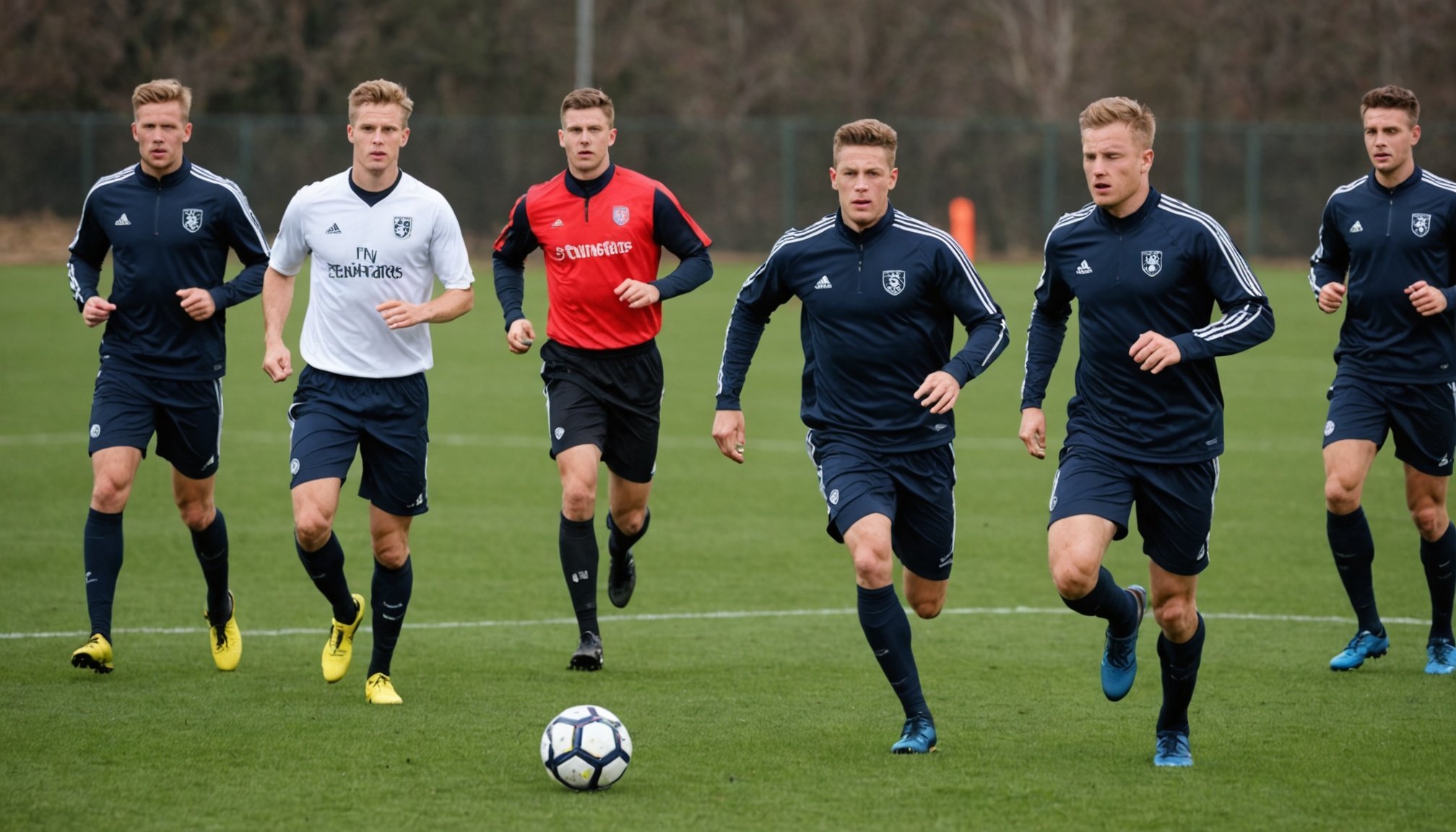Maximizing Performance: Innovative Strategies for Football Teams to Enhance Pre-Match Warm-Up Routines
The Importance of Pre-Match Warm-Ups in Football
When it comes to football, the pre-match warm-up is more than just a routine; it’s a crucial component of a team’s preparation that can significantly impact performance and injury prevention. A well-structured warm-up routine can elevate a team’s chances of success by ensuring that players are physically and mentally ready for the game.
Physiological Benefits
A proper warm-up increases blood flow and body temperature, preparing the muscles for high-intensity activities. Here are some key physiological benefits:
This might interest you : Unlocking Mental Mastery: Top Strategies for Footballers to Boost Cognitive Skills on the Field
- Increased Blood Flow and Body Temperature: This helps to reduce the risk of muscle strains and other injuries by making the muscles more flexible and responsive[3].
- Enhanced Metabolic Processes: A warm-up activates the metabolic pathways that provide energy to the muscles, allowing players to perform at a higher intensity from the start of the game.
- Improved Neural Function: Warming up stimulates the nervous system, enhancing reaction times and coordination.
Psychological Preparation
Beyond the physical benefits, a warm-up also plays a significant role in psychological preparation. It helps players to focus, build confidence, and get into the right mindset for the game.
- Reduced Anxiety: A structured warm-up can help players feel more comfortable and prepared, reducing pre-game anxiety.
- Team Cohesion: The warm-up is an opportunity for the team to come together, reinforcing teamwork and communication.
Innovative Strategies for Warm-Ups
Modern football teams are adopting innovative strategies to maximize the effectiveness of their warm-up routines. Here are some cutting-edge approaches:
Additional reading : Top Post-Match Recovery Strategies for Football Players Aged 30 and Above
Dynamic Stretching and Mobility Exercises
Static stretching, once a staple of warm-ups, has given way to dynamic stretching and mobility exercises. These movements mimic the actions of the game, preparing the muscles in a more functional way.
- Leg Swings and Lunges: These exercises improve hip mobility and prepare the legs for sprinting and changing direction.
- Arm Circles and Shoulder Rotations: These help to loosen the shoulders and prepare the upper body for throwing, heading, and other movements.
- High Knees and Butt Kicks: These exercises warm up the lower body and improve running mechanics.
### Example Warm-Up Routine
- **Phase 1: Light Cardio (10 minutes)**
- Jogging laps around the field
- High knees and butt kicks
- Arm circles and shoulder rotations
- **Phase 2: Dynamic Stretching (10 minutes)**
- Leg swings (front and back)
- Lateral lunges
- Hip circles
- **Phase 3: Strength and Power Exercises (10 minutes)**
- Squat jumps
- Box jumps
- Resistance band exercises
- **Phase 4: Game-Specific Drills (15 minutes)**
- Passing drills
- Shooting practice
- Small-sided games
Strength Conditioning and High-Intensity Training
Incorporating strength conditioning and high-intensity training into the warm-up routine can significantly enhance football performance.
Strength Conditioning
Strength training is not just for the gym; it can be integrated into the warm-up to prepare players for the physical demands of the game.
- Resistance Band Exercises: These can be used to strengthen the legs, hips, and upper body.
- Bodyweight Exercises: Squats, lunges, and push-ups can be modified to fit into the warm-up routine.
High-Intensity Interval Training (HIIT)
HIIT involves short bursts of high-intensity exercise followed by brief periods of rest. This type of training can be particularly effective in preparing players for the intermittent nature of football.
- Sprint Intervals: Short sprints followed by walking or jogging to recover.
- Agility Drills: Shuttle runs and cone drills to improve speed and agility.
Recovery and Injury Prevention
Recovery and injury prevention are critical components of any football training program, including the warm-up routine.
Active Recovery
Active recovery techniques can be incorporated into the warm-up to help players recover from previous training sessions and games.
- Light Jogging: Gentle jogging to keep the blood flowing and aid in the removal of waste products from the muscles.
- Foam Rolling and Self-Myofascial Release: These techniques can help reduce muscle soreness and improve flexibility.
Injury Prevention Exercises
Specific exercises can be included in the warm-up to target common injury-prone areas.
- Core Strengthening: Exercises like planks and side planks to strengthen the core muscles, which are essential for stability and balance.
- Hamstring and Groin Strengthening: Exercises like deadlifts and adductor squeezes to strengthen the hamstrings and groin area.
Case Studies and Expert Insights
Real-world examples and expert insights can provide valuable lessons for teams looking to enhance their warm-up routines.
UEFA Women’s Football Strategy
The UEFA’s “Unstoppable” strategy for women’s football emphasizes the importance of tailored training programs, including warm-ups, to enhance performance and reduce injuries[1].
- Tailored Training Programs: The strategy highlights the need for training programs that are specifically designed for women’s football, taking into account the unique physiological and psychological needs of female players.
African Football Coaching
In African football, coaches like Hugo Broos emphasize the importance of adapting training and warm-up routines to the specific needs and conditions of African players[3].
- Cultural and Environmental Adaptation: Broos stresses the need to consider the cultural, environmental, and physical characteristics of African players when designing training and warm-up programs.
Practical Advice for Coaches and Players
Here are some practical tips for coaches and players to maximize the effectiveness of their warm-up routines:
Create a Structured Routine
- Phase-Based Approach: Divide the warm-up into phases, each focusing on a different aspect such as cardio, dynamic stretching, strength, and game-specific drills.
- Time Management: Ensure the warm-up is long enough to be effective but not so long that it tires the players out before the game.
Use Technology and Data
- GPS Tracking: Use GPS tracking devices to monitor players’ heart rates, distance covered, and other metrics to tailor the warm-up to their specific needs.
- Video Analysis: Analyze game footage to identify areas where players need to improve and incorporate specific drills into the warm-up.
Focus on Recovery
- Active Recovery Techniques: Incorporate active recovery techniques such as light jogging and foam rolling into the warm-up to aid in recovery from previous sessions.
- Nutrition and Hydration: Ensure players are properly hydrated and fueled before, during, and after the warm-up.
A well-designed pre-match warm-up routine is essential for maximizing football performance and preventing injuries. By incorporating innovative strategies such as dynamic stretching, strength conditioning, and high-intensity training, teams can ensure their players are physically and mentally prepared for the game. Remember, the warm-up is not just a precursor to the game; it is an integral part of the overall training program that can make a significant difference in achieving peak performance.
### Sample Weekly Training Schedule
| Day | Training Session | Warm-Up Routine |
|
|------------------------------------------|
|
| Mon | Strength Conditioning | Light cardio, dynamic stretching |
| Tue | High-Intensity Interval Training (HIIT) | Sprint intervals, agility drills |
| Wed | Rest and Recovery | Active recovery techniques |
| Thu | Game-Specific Drills | Passing drills, shooting practice |
| Fri | Light Training | Light cardio, static stretching |
| Sat | Match Day | Full warm-up routine |
| Sun | Rest and Recovery | Active recovery techniques |
By following these strategies and tips, football teams can enhance their pre-match warm-up routines, leading to improved performance, reduced injuries, and a competitive edge on the field.











